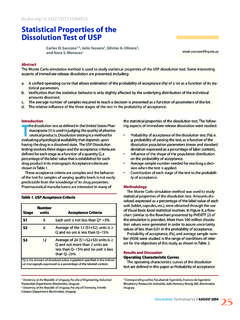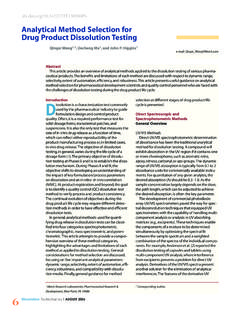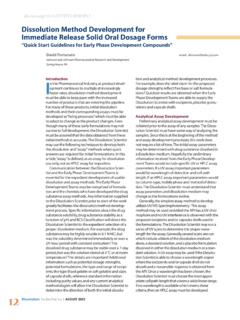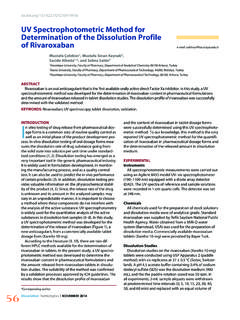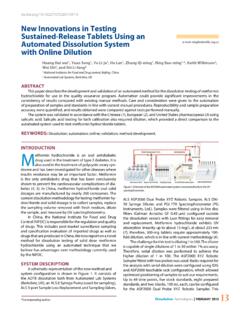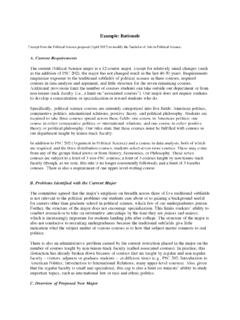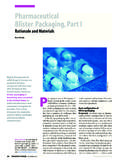Transcription of Rationale for Selection of Dissolution Media: Three …
1 Rationale for Selection of Dissolution media : Three Case Studies Nikoletta Fotaki1, William Brown2, Jianmei Kochling3, e-mail: Hitesh Chokshi4, Hai Miao5, Kin Tang4, and Vivian Gray7,*. 1 University of Bath, Bath, UK. 2 United States Pharmacopeial Convention, Rockville, MD, USA. 3 Genzyme, Waltham, MA, USA. 4 Roche, Nutley, NJ, USA. 5 Vertex Pharmaceuticals, Cambridge, MA, USA. 6V. A. Gray Consulting, Inc., 9 Yorkridge Trail, Hockessin, DE, 19707, USA. ABSTRACT. The Selection of media in Dissolution method development can sometimes be an arbitrary decision. The case studies in this article give a practical Rationale that should help in selecting media , especially surfactants.
2 Three cases were studied: (1) the role of surfactants versus compound stability in the Dissolution medium during dissolu- tion method development, (2) the Selection of a surfactant based on interactions between the Dissolution medium and the drug substance, and (3) the Selection of media based on formulation properties. In the first case study, the choice of surfactant in relation to solubility and physical stability of the drug substance is shown. The second revealed an unexpected synergy between polysorbate 20 (Tween) and acetic acid solution that caused an unusual increase in the Dissolution rate compared with these media used separately.
3 In the last case study, the medium was modified by addition of surfactant to reflect a change in the formulation. The Selection of a Dissolution medium should be based on drug substance and formulation characteristics as well as on interactions among components. INTRODUCTION nonionic ( , Tween or Cremophor EL) (4), as shown in T. he media typically used in Dissolution studies Figure 1. include acidic solutions, buffers, surfactants, and Surfactants exist as monomers at low concentration in surfactants with acid or buffers (1). media with bile solutions. Aggregation occurs with increasing concentra- salts and other relevant physiologically based ingredients, tion and results in the formation of micelles.
4 The minimum sometimes called biorelevant media , can be used in regu- concentration of a monomer at which micelles form is latory tests, but typically are used as research tools or for called critical micelle concentration (CMC). The stability of in vitro in vivo correlation studies (2). micelles is related to their CMC value: the lower the CMC. Surfactants are used in Dissolution test methods to value of a given surfactant, the more stable the micelles improve the solubility or wettability of a drug. Sometimes (5) (Table 1). In Dissolution testing, the micelle of surfac- the decision to use a surfactant is based solely on the tant molecules mimics the bile acid aggregates in the fact that it will facilitate drug Dissolution and not on any small intestine; the surfactant facilitates the diffusion and further study.
5 It is thus important to understand scientifi- transport of the free solute into the bulk medium. Since cally the interaction mechanisms between different types Dissolution is a combined effect of solubility and diffusiv- of surfactants and drug molecules as well as interactions ity, the micelle size will have an effect on the Dissolution with excipients. This understanding should guide the ana- rate of molecules when different surfactants are used. lyst in selecting the most appropriate media for methods Micellar-driven drug solubilization occurs with an increase that will be used in formulation development and drug in the number of micelles when the surfactant concentra- product Dissolution testing.
6 Tion is higher than the CMC value (6). In fact, solubility Surfactants reduce solution and surface interfacial enhancement is a function of surfactant concentration. tension by replacing water molecules on the surface (3). This relationship generally can be found for different sur- Surfactant molecules include two distinct components, factants and different compounds (3, 7, 8). the head (hydrophilic area) and the tail (hydrophobic Micellar drug solubilization is affected by many factors: area). Surfactants can be classified as anionic ( , so- the nature of the surfactant and the drug substance ( , dium lauryl sulfate [SLS], also known as sodium dodecyl nonpolar molecules are solubilized in the micellar core, sulfate [SDS]), cationic ( , cetyl trimethyl ammonium whereas those with intermediate polarity are distributed bromide [CTAB]), zwitterionic ( , alkyl betaine), or along the surfactant molecules in certain intermediate positions), temperature, pH, and ionic strength (3, 6).
7 For *Corresponding author. ionic surfactants, the CMC values decrease and the micel- 6 Dissolution Technologies | AUGUST 2013. Table 1. CMC Values (mM) of Commonly Used Surfactants in Water at 25 C. Surfactant Type CMC (mM). Triton X-100 Nonionic Tween 20 Nonionic Tween 40 Nonionic Tween 80 Nonionic CTAB Cationic 1. SLS Anionic 7 10. the Dissolution rate and solubility of the drug sub- stance. For example, the Dissolution rate of ibuprofen from tablets in HCl solutions with different surfactants (cationic, anionic, and nonionic) is not affected by the Figure 1. Structures of commonly used surfactants in Dissolution : SLS.
8 Surfactants, even though the solubility of ibuprofen was (anionic), CTAB (cationic), and Tween 80 (nonionic). significantly different in these solutions (9). Another ex- ample is griseofulvin, for which addition of several con- lar size increases upon addition of an electrolyte to the centrations of ionic (SLS, CTAB) and nonionic (Tween solution. The type of surfactant determines the effect of 80) surfactants resulted in a greater enhancement of ionic strength; for example, the solubility of mefenamic drug solubility relative to its Dissolution (3). Interest- acid is affected by a change in ionic strength when SLS is ingly, the enhancement of the solubility to Dissolution used but not when CTAB is used (9).
9 In addition, the purity ratio was almost constant in all cases except for the of the surfactant must be considered because it can exten- low concentration of SLS and the high concentration of sively affect the size and loading capacity of a micelle, CTAB (Figure 2). which results in changes in solubility and Dissolution rate In dosage systems that contain polymer, the interac- (10, 11). Moreover, interactions among the ions and the tions between polymers and surfactants in aqueous type of surfactant used must also be considered care- media give rise to the formation of association structures, fully when Dissolution media are selected.
10 For example, thereby modifying the solution and interfacial properties. potassium ions can interact with SLS, forming an insoluble The morphologies of association complexes depend on product (12). the molecular properties of the polymer and the sur- For acidic drugs, media containing cationic surfactants factant. The presence of a polymer lowers the CMC and are better able to discriminate Dissolution rate than media reduces the size of spherical micelles (13, 14). containing other types of surfactants (9). The first case study examines the choice of surfactant An important point about the use of surfactants in (anionic, cationic, or neutral) in terms of the solubility and Dissolution media is that they have different effects on physical stability of the drug substance.
